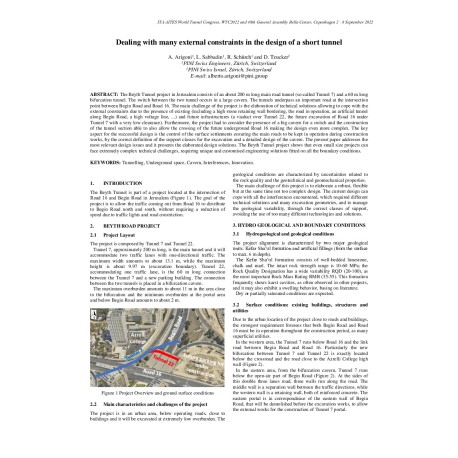Cart
0
0
No document
0,00 €
Total
Document successfully added to your shopping cart
Quantity
Total
There are 0 items in your cart.
There is 1 item in your cart.
Total documents
Total shipping
To be determined
Total
Search & filter
Search for a publication
Search & filter
Dealing with many external constraints in the design of a short tunnel
Dealing_With_Many_External_Const
A. Arigoni / L. Sabbadin / R. Schürch / D. Tzucker
The Beyth Tunnel project in Jerusalem consists of an about 200 m long main road tunnel (so-called Tunnel 7) and a 60 m long bifurcation tunnel. The switch between the two tunnel occurs in a large cavern. The tunnels underpass an important road at the intersection point between Begin Road and Road 16. The main challenge of the project is the elaboration of technical solutions allowing to cope with the external constraints due to the presence of existing (including a high stone retaining wall bordering, the road in operation, an artificial tunnel along Begin Road, a high voltage line, ...) and future infrastructures (a viaduct over Tunnel 22, the future excavation of Road 16 under Tunnel 7 with a very low clearance). Furthermore, the project had to consider the presence of a big cavern for a switch and the construction of the tunnel section able to also allow the crossing of the future underground Road 16 making the design even more complex. The key aspect for the successful design is the control of the surface settlements ensuring the main roads to be kept in operation during construction works, by the correct definition of the support classes for the excavation and a detailed design of the cavern. The present paper addresses the most relevant design issues and it presents the elaborated design solutions. The Beyth Tunnel project shows that even small size projects can face extremely complex technical challenges, requiring unique and customised engineering solutions fitted on all the boundary conditions.




